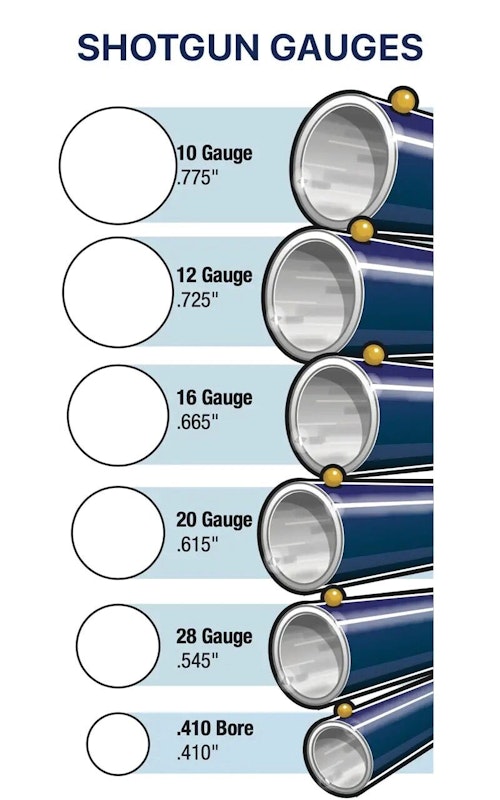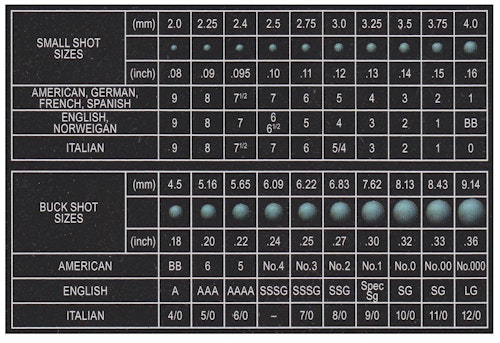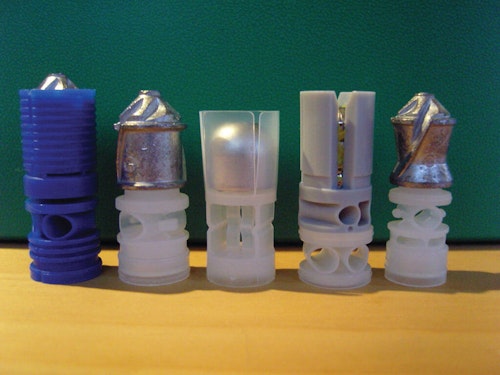Everyone has heard of birdshot and buckshot, but beyond those are a wide variety of exotic loads that fire everything from bean bags, rubber balls, cayenne pepper, flechettes, hollow-point slugs that you can pack with anything you’d like, and even one that can fire a 50-foot blast of flaming incendiary metal.
That’s part of the scariness of facing a shotgun: There’s no way to know what it may have in the chamber. Excluding these special-purpose shells, there are many available loads and the number of choices can be confusing for customers. Let’s examine the basics.
Diameters and Length
The diameter of the bore is the first consideration and the first thing listed on a box of shotgun shells. Standard bore sizes range from .775 down to .410 inches, but rather than using these caliber designations as with pistol or rifle ammunition, they are commonly referred to by the more archaic “Gauge.” Gauge refers to the number of round lead balls with the bore’s diameter it would take to equal a pound of lead. For instance, it takes 12 round balls to make a pound of lead for a 12-gauge shotgun barrel. The 20-gauge barrel would take 20 balls due to the smaller bore diameter. In other words, a single lead ball fitting a 12-gauge barrel would weigh 1/12 pound, and one for a 20-gauge would weigh 1/20 pound.
The lone exception in this classification is the .410. While often called a .410 gauge, the .410 shotgun has a barrel measuring .410 inches in diameter. It’s technically a .41-caliber shotgun. The public, however, has made it commonly known as a .410 gauge. That’s technically inaccurate, but the term has stuck.
The next measurement on a box of shells refers to the length of the shell. This must be matched to the particular gun being used. A 12-gauge shotgun can have a chamber length between 1¾ to 3½ inches. The most common will be 2¾, 3, or 3½ inches. One should always match the shell’s length with the chamber size. It’s easy to find the gauge and chamber length because it will be stamped on the shotgun’s barrel. Never shoot a shell that is longer than the chamber length. It is OK, however, to shoot a shorter shell in a longer chamber. A 3½-inch chamber can fire a 2¾-inch shell, but a 2¾-inch chamber can only fire 2¾-inch shells.
Velocity and DRAM
The muzzle velocity is usually listed next. It’ll be listed in feet per second (fps) like rifle and pistol ammunition. The higher numbers will be faster and will have more recoil for the shooter to contend with. Often DRAM equivalents are listed. It’s an old measurement of the amount of blackpowder that would produce the same velocity as the shells in the box. One dram is about 1/16 ounce of blackpowder. It’s important to note that 1/16 ounce of black powder does not compare to 1/16 ounce of modern, smokeless powders. Current powders are much more powerful. Using the dram measurement with modern powders would result in the shotgun exploding. Your customers are much safer if they stick with the rated velocity rather than the dram equivalent.
Shot Size and Weight
The last measurement involves the size and overall weight of the shot loaded. There are two main categories of shot to consider. The first is birdshot, which is used for fowl and small game. The second is buckshot used for medium to large game as well as tactical and self-defense purposes. The two categories use the same terminology but are not interchangeable — No. 4 birdshot is not the same as a No. 4 buckshot.
It’s possible to load different amounts of birdshot in the shell by varying the wad separating the powder from the shot. For example, it’s common to find 12-gauge, 7 ½ shot loaded in either ¾-ounce, 1-ounce, or even 1 ¼-ounce. The heavier load will produce more recoil, an essential consideration for recoil-sensitive shooters. My daughter used ¾ ounce of 7½ shot for trap shooting in a lower-velocity shell. It was much more enjoyable to shoot compared to the heavier loads. There is no magic formula, although there are general recommendations; finding what is right is a matter of trial and error.
Put It All Together
Knowing the above numbers is essential, but it still doesn’t answer which box of ammo your customers should buy. There are charts that provide typical choices. These are great starting points. They will then have to try the various recommendations and determine what works in their situation. What they choose for a typical 20-yard distance may not be the same as when the distance is 40 yards. It’s trial and error on the shooter’s part.
The considerations for buckshot are not so clear-cut. Variations in weight are not typical for the same size of shot. Only so many No. 00 buck pellets will fit into a 3-inch casing. There can still be variations in velocity.
The most common selections for hunting deer-size game are No. Buck up to No. 00 Buck. The same holds for self-defense situations. My home-defense shotgun is loaded with No. 4 Buck, and as a police officer, I carried No. 00 buck or rifled slugs. The criminals know these are typical choices for police and home defense, and it’s surprising how intimidated they are by the sound of a shotgun shell being racked into the chamber. It changed their plans every time I did it when working on the street.
Slugs and Sabots
There is one last category to discuss — single projectile rounds. Rather than having multiple pellets of birdshot or buckshot, shotguns can also fire a single projectile. This is a solid lead slug (bullet) of the same diameter as the shotgun’s bore. Most shotguns have a smooth bore, so these slugs are usually rifled on their outer diameter to make it act as if it was fired from a rifled barrel. The spin stabilizes the slug and enables it to have incredible accuracy. I’m sure you can imagine the damage caused by a ¾-inch projectile compared to a rifle cartridge like the .308 Winchester, which is less than half the size. At ranges inside 100 yards, it is devastating.
Some shotguns have rifled bores and are designed exclusively to fire single projectiles. Rather than firing slugs, they fire a smaller-diameter projectile that loosely resembles a rifle bullet. The difference is that this bullet is held in the center of the bore by a plastic sabot (casing) that engages the barrel’s rifling and imparts the stabilizing spin. The sabot then separates as it exits the barrel, leaving only the bullet to continue to the target. Increased accuracy and distance are the advantages of a sabot slug fired from a rifled barrel. They essentially turn the shotgun into a rifle, albeit a low-velocity one.
Final Thoughts
The information above is not exhaustive but it provides an overview of the basics, allowing your customer to understand the terminology on a box of shotgun shells. It’s enough to start them on their journey and will enable them to learn the subtle differences in load choices. Don’t just sell one box to go with their new shotgun. Instead, sell them several variations and let them experiment to find what works best for them. Get them to try different shot sizes, buckshot, and even slugs. They’ll soon find out why shotguns are so popular and effective.









